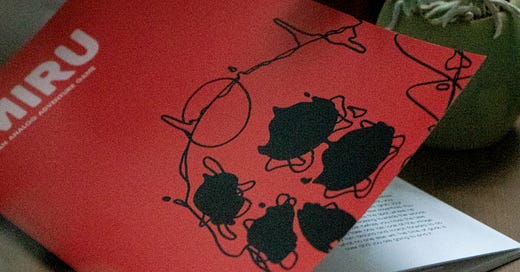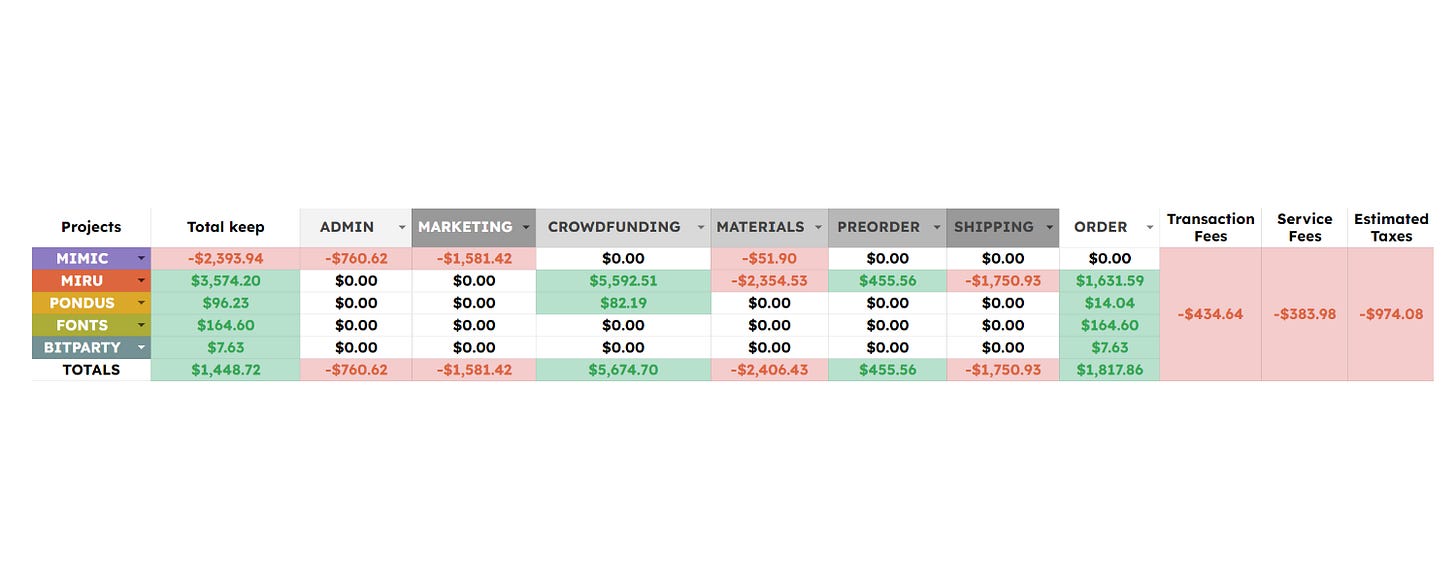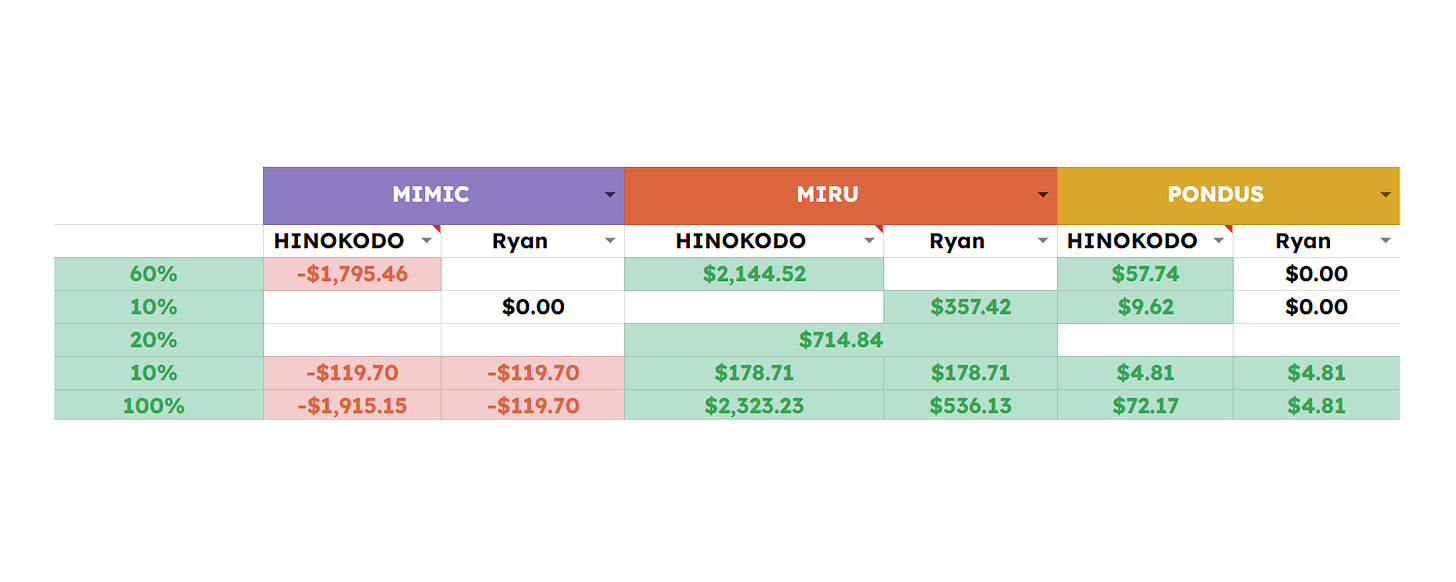At Mimic, we believe in a little thing called Radical Transparency. For us, that means that we keep very little from the public. (Sometimes we don’t tell you stuff we’re working on because the surprise is half the fun!)
This has an awful side effect called Oversharing. If you’re at all familiar with Hinokodo’s Discord, you’ll know what we’re talking about. No filter allows for maximum creativity to flow and the bouncing of ideas between our favorite artists, but it also means you’re getting huge blocks of text.
This End-of-Year Report will try not to be a wall of text of boring ideas and thoughts, but tangible numbers and lessons for us all to learn from. With that, let’s dive in.
First let’s catch up: We launched our first project (and Mimic) in 2019. It didn’t go well. We were new and inexperienced. We learned a lot, retooled during the (never-ending) pandemic, and moved to Massachusetts.
In August of 2022 we launched MIRU: An Analog Adventure Game on Kickstarter during Zinequest 4. With a humble goal of only $100, we somehow were able to raise over $7,000!
We also soft-launched PONDUS: An Analog Wyzard Game on Itch.io as an experimental slowfunding project in November of 2022. The donations made here will apply to a physical order if people choose to purchase the physical edition once the goal is reached.
Hinokodo released 2 new fonts on Itch.io. As a member (and as co-founder) 20% of the profits from his projects published under us, go to help make future projects for all members of the collective.
We also released 2 Enamel Pins (with a 3rd on the way!)
All of these projects were released in the second half of the year. Making for a very exciting end of 2022 for us! While December isn’t quite complete, we have sold just about 500 physical orders (470 as of 12/8). This is a mix of MIRU & Pins (but mostly MIRU) This leads us to the next section:
We are not in debt!
As our first real year of operation, there are startup costs. Our biggest was purchasing a camera to help us film & market our products. (We found a Sony a7II on eBay for about $1000 at the beginning of the year, what a steal!) We also had to set up a website, pay our Adobe subscription (We have since moved to Affinity!), and pay off our first round of pins. These things can add up!
Thankfully MIRU did really well during its Kickstarter. Since then We’ve sold almost 150 more physical copies here in the US & internationally!
This year was also a time for us to experiment with our structure and payout system. For context, we are a collective (a group of individuals operating under 1 umbrella) with a horizontal cooperative structure. (Basically, all members are equal owners, have equal say & equal pay)
Every 6 months we break down the math and divvy up funds based on the following formula:
Major Contributors - 60%
Minor Contributors - 10%
Mimic Admin/Marketing - 20%
All Members - 10%
So for Example with MIRU, Hinokodo was the creator (He created the concept, wrote it, did all of the art, and did the layout) and Ryan helped with editing. So in this case, Hinokodo has the major credit, and Ryan has the minor credit. Without the work they each put in, MIRU wouldn’t be what it is today. (If there’s a future project with 2 major creators they would split it 30/30%. If there were no minor contributors then the Major(s) would absorb that 10%)
Our numbers for the 2nd half of 2022 (as of 12/8) are as followed:
As you can see, the cost to run a business, even one as simple as ours, printing & shipping zines, can cost quite the arm and a leg.
Admin & Marketing include our startup costs, which, should not continue through the next few years. We include research purchases in our marketing budget as we explore the field, see what is out there, what quality people expect from game makers & publishers, and so on.
Materials include shared member materials, like our sticker purchases as we prepare our first sticker pack for next year. (The idea is to include something from all the members eventually)
Towards the end of the chart you’ll see Transaction Fees & Service Fees. These costs are usually hidden from customers, but they are ‘costs of doing business’. They include Paypal & Stripe fees as well as fees to host on sites like Itch.io & Kickstarter. Something like 10% of revenue goes into this bucket.
Dealing with sales tax online is a little weird, and so we’ve set aside about 10% of our revenue for that purpose to be solved by a savvy accountant in the next few months.
This chart also shows us which projects are bringing in the most revenue, as well as what costs are associated with making that project a reality.
Let’s take a look at MIRU.
If you look at our Kickstarter page, you’ll see that we raised $7,137. So why do we only keep $3,574 after 4 months of sales?
Under Crowdfunding, you’ll see we only got to keep $5,592. Some people dropped out or blocked their cards from getting charged (That’s ok, it happens!), then Kickstarter has a 5% fee, and then there’s about a 5% transaction fee on top of that. (Make your goal about 10% more than what you need folks!)
Now that we got our crowdfunding money, we needed to buy everything! We put this under Materials. Things like the zine itself, the dice, the mailers just for MIRU, the little notebooks, etc. Thankfully some beautiful souls who missed the Kickstarter pre-ordered on our site giving us an extra $455 boost! But then you can see under shipping, we’ve spent $1,750 straight to the USPS! Since the campaign, we’ve managed about $1,630 in sales from our site and wholesale orders from our UK partners (Say hi to Peregrine Coast & The Lost Bay Studios if you’re outside the US!) Minus all those transaction fees, service fees, and sales tax and we’re left with $3,574 in income.
Now that we know our income, we can begin splitting it among the members & contributors accordingly. Showing this accurately in a spreadsheet is quite the challenge, but here’s a sample.
We treat Mimic like its own project. (One that will likely always be in the negative) So here we see quite a bit of red under mimic. If a project is supposed to reward contributors with profits, it unfortunately means it is supposed to reward them with the expenses (Members ARE owners after all).
Under the MIRU tab we can see that because Hinokodo was a Major Contributor, he’ll receive $2,145 for his 60% cut, and Ryan will get $357 for her editing contribution in the minor role. (In the future as we collab with more folks, who gets what contribution tag will be an ongoing discussion determined among the people who are involved in each project! Sometimes this may mean paying some contributors up front, because splitting up 10% among several people may not be a reasonable wage.)
Mimic gets a 20% cut to help fund all the projects, and for MIRU, it will receive about $715. Then finally, because Hinokodo & Ryan are both members of the collective, they get to split 10% of all profits made under all projects. (This is to help smaller projects that may never take off or were never meant to really bring in money. A rising tide lifts all boats & sharing is caring!) In this case they each get about $179.
There were a few other projects we’ve launched this year, but just as an example, if we look at PONDUS. So far Hinokodo is receiving $72 for his contributions and Ryan is getting about $5 for being a member. This may seem a little silly (and it is a little in this case, $5 ain’t much) but as time goes on and we add more members and way more projects, the payouts for members, on projects they did not help with, will begin to add up, and help supplement the life of a creative.
Imagine a scenario where you are known to only make 1 big project a year, but you still have bills monthly! While the other members can make 4+ projects a year. The member payout system, should allow for SOMETHING to come to that member who may only make 1 thing a year. Not all systems are perfect and we’re still tweaking things, but we feel that this setup fits us and hopefully someday it may fit you if you’re a creative looking to be part of something bigger.
We’ll make this purchase closer to the end of the year as we expect a few more sales. But as it stands, as of 12/8, we’ll owe about $66 to offset 4,000kg of emissions to make this project a reality.
Why Carbon Offset? So for us, we think it’s important to leave the earth better than we found it. We really don’t want to be ‘just another brand that makes stuff’. That’s why, as best we can, all of our products are compostable, biodegradable, made with recycled materials, and/or made to last a lifetime (like our dice and enamel pins). So we do our best to begin with, but the current state of our world and capitalism is in love with oil, and so unfortunately there’s just no escape from creating products that are truly carbon negative (at least not yet).
That why we’ve done some very thorough internet research to determine the carbon costs of the products we create & sell. Some examples are these:
A paperback book creates about 1kg of emissions.
A small cardboard mailer creates about .25kg of emissions.
Shipping a 1lb package is about .5k of emissions (travel range, weight, vehicle all vary this number)
We include the materials, the packaging, the shipping to us, costs from storing & working, and shipping to you. Just in case these numbers are off, we double it.
So for us (as of 12/8) we estimate about 2,000kg is created from our business, so we’re offsetting 4,000kg. We’re donating through CoolEffect.org which helps people across the globe with projects that offset the emissions we create living our oil-friendly modern lives.
While we include the costs of our office space, we aren’t offsetting the costs of our members just yet. We hope to be able to afford to do so in the future. (It ends up being close to $200/American per year, even though we know we use less - we don’t have a car for instance - we would like to keep up with doubling our offsets… in time!)
These numbers include offsetting all of our wholesale orders out to the UK as well! So rest assured, while not a perfect system, we are trying to have a positive impact on our only home.
We consider our first year a trial run. Get our feet wet and set up systems to handle the chaos that is running a business. Are you a creative who doesn’t want to really deal with the headache of running a business? Want to be part of a creative team that operates independently but sometimes collaborates with each other in-house? Want to make games, books, or art without the hierarchy?
Beginning in 2023 we will open memberships to at least 2 other people. You will likely see an update with more details in our next quarterly newsletter. So stay tuned!
We have a few projects in the works and here are our tentative schedule for their releases:
MIRU II: An Analog Horror Game - February (Zinequest 5)
BITPARTY 2.0 - March through August (Chapter a month, Famicom box set in August)
PONDUS - October (the complete set)
GLITCH - TBA (likely summer 2024)
We’re excited to build out the portfolio of engaging games for all of you to play and experience. Continuing MIRU as a Zinequest series, updating and expanding the classic BITPARTY games, seeing how the slowfunded PONDUS pans out, and beginning the work on what we think will become Hinokodo’s magnum opus, GLITCH, is extremely thrilling. This is not an exhaustive list of releases, as we have a few secret collaborations in the works. Consider the list above our big titles and we may release a few smaller game jam session games in between.
To expand our current membership. We would love to share this space with other like minded creatives. It’s very hard to start a creative career on your own, and we hope we can help a few people feel like their part of a team while keeping their independence.
To expand into a real physical space. Across the street from our 650sqft apartment (where we put together over 300 kickstarter orders in 2 weeks) There are art studio spaces for rent at very affordable pricing. They are located near a brewery (people walking by!) and will often have ‘meet the artist’ days where the public can walk through the halls and visit artist shops (means more local & public exposure!) Another space is desperately needed in order to keep our very tiny apartment from looking like a warehouse 24/7.
To keep up with product releases. It’s one thing to plan things out, it’s another to execute them with pizzaz! So we’re just hoping we can keep this pace up. We’re to the point where we’re spacing things out a year or two in advance now, so as long as we keep burnout in mind and not overwhelm ourselves into crunch mode before releases, we should be ok!
We’re hoping to double sales in 2023. As most artists & creatives would agree, working full time on your passions & things that bring you joy, is much preferable over the drag of modern career options. Being able to do this full time through the year would be preferable. It brings us joy and we hope the projects we get to breathe life into bring you joy as well.
That concludes this year’s annual report!
We would love to hear from you in the comments or on our socials, specifically Twitter, Instagram, or our Mastodon!
Ryan doesn’t have much of a social media presence, but you can follow her fiancé Hinokodo on Twitter, Instagram or Mastodon!
While you’re here you should follow these wonderful people and teams that also have great newsletters!
















